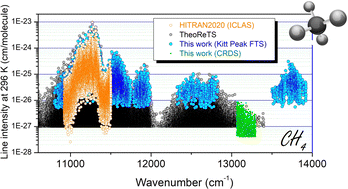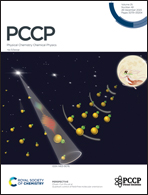The high resolution absorption spectrum of methane in the 10 800–14 000 cm−1 region: literature review, new results and perspectives†
Abstract
The recent development of high resolution spectrographs for exoplanetary research in the visible range makes suitable an improvement of our knowledge of the high resolution spectrum of methane. In this contribution, the weak and highly congested absorption spectrum of methane in the 10 800–14 000 cm−1 region (0.71–0.93 μm) is considered on the basis of (i) an exhaustive review of the literature over the lasts decades, (ii) the analysis of a spectrum recorded at Kitt Peak by Fourier transform spectroscopy at room temperature, (iii) a very high sensitivity spectrum recorded by cavity ring down spectroscopy near 760 nm. The line list retrieved from the Kitt Peak spectrum includes 12 800 lines between 10 802 and 13 922 cm−1. Together with the CRDS line list in the 13 060–13 300 cm−1 interval (about 2650 lines), the reported FTS dataset represents the first high resolution extensive intensity measurements of methane for wavenumbers above 11 502 cm−1. A very good agreement between our Kitt Peak line list and HITRAN list is found in the 10 800–11 502 cm−1 interval. The “quasi-continuum” absorption background underlying the congested spectrum around 11 200 cm−1 is quantitatively evaluated to about 42% of the absorption by CH4 lines. Previous laser-based investigations are critically reviewed by comparison to the FTS and CRDS experimental data retrieved in the present work. The review of the studies of the minor isotopologues (13CH4, CH3D, CH2D2, and CHD3) is also presented. Intensity comparison with band models used for planetary applications is discussed and confirms the importance of the “quasi-continuum” absorption in the methane spectrum at room temperature. The comparison to the TheoReTs line list obtained by ab initio calculations gives valuable hints for future assignments but the TheoReTS line positions are not sufficiently accurate for application to high resolution exoplanetary spectra in the region. From the various comparisons and results obtained in this work, we conclude that the high frequency absorption spectrum of methane deserves to be revisited by modern cavity-enhanced absorption techniques to fulfil needs both for future analysis of high resolution exoplanetary spectra and for theoretical analysis.

- This article is part of the themed collection: 2023 PCCP Reviews


 Please wait while we load your content...
Please wait while we load your content...